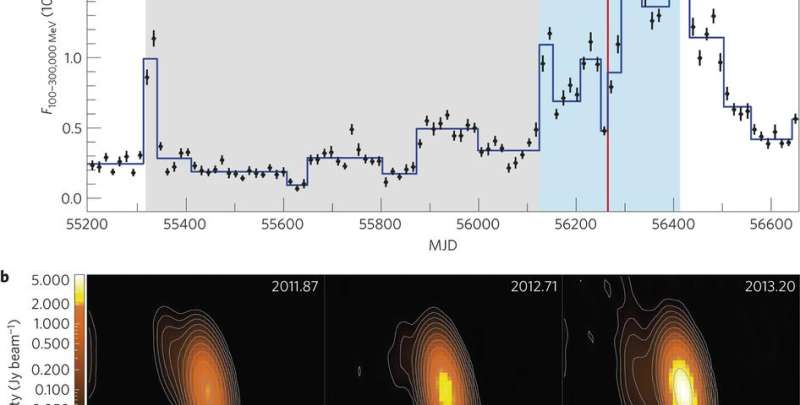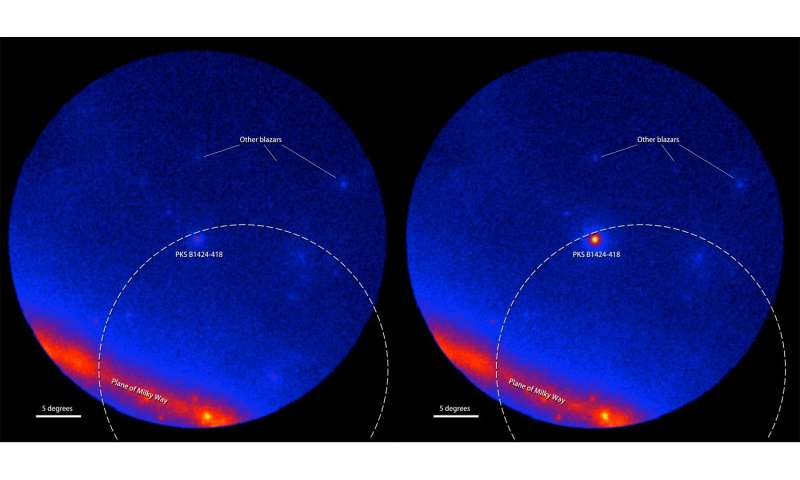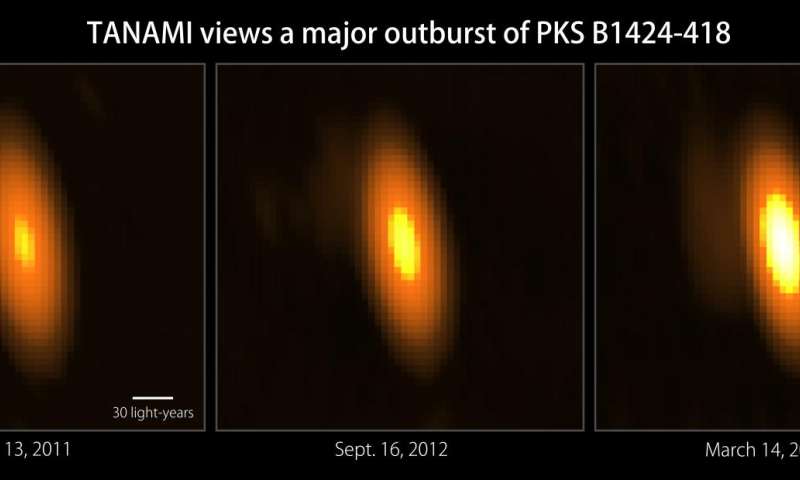April 19, 2016 report
First high-energy neutrino traced to an origin outside of the Milky Way

(Phys.org)—An international team of researchers has spotted the first instance of a high-energy neutrino collision from a source outside of the Milky Way, marking what they describe as a significant discovery. In their paper published in the journal Nature Physics, the team describes their work at the South Pole Neutrino Observatory, the details pertaining to the sighting and why they believe their discovery may lead to a new era in neutrino astrophysics.
Neutrino's are massless and have no charge and very seldom interact with other matter—the exception is when they collide head on with another particle. Scientists have been studying neutrinos for several years, believing that they may hold the key to understanding many parts of the universe that remain otherwise hidden from our view. To see evidence of them, researchers fill large underground tanks with different types of fluids and then use extremely sensitive sensors to capture very brief flashes of light which are emitted when a neutrino collides with something in the fluid. The team with this latest effort has taken a different approach, they have placed sensors around a kilometer sized ice cube 2.5 kilometers beneath the surface, in a location near the South Pole. The sensors capture the brief flashes that occur when neutrinos collide with particles in the ice.
Capturing evidence of collisions does not happen very often, but when it does, it sets off a chain of events that center around trying to ascertain where the neutrino came from—most come from the sun or cosmic rays striking our atmosphere. But back in 2012, the team captured evidence of what they described as the most powerful yet, registering two petavolts. Following that discovery, the team used data from radio telescopes, and in particular data from a galaxy that has been named KS B1424-418—astrophysicists have been studying it for several decades and it had been observed to undergo a change in shape during the time period 2011 to 2014. After much analysis, the team confirmed that the neutrino collision they observed was due to an emission from that very galaxy, making it the first neutrino collision to be traced back to a source outside of the Milky Way.
-

Fermi LAT images showing the gamma-ray sky around the blazar PKS B1424-418. Brighter colors indicate greater numbers of gamma rays. The dashed arc marks part of the source region established by IceCube for the Big Bird neutrino (50-percent confidence level). Left: An average of LAT data centered on July 8, 2011, covering 300 days when the blazar was inactive. Right: An average of 300 active days centered on Feb. 27, 2013, when PKS B1424-418 was the brightest blazar in this part of the sky. Credit: NASA/DOE/LAT Collaboration -

These radio images from the TANAMI project reveal the 2012-2013 eruption of PKS B1424-418 at a radio frequency of 8.4 GHz. The core of the blazar's jet brightened by four times, producing the most dramatic blazar outburst TANAMI has observed to date. Credit: TANAMI
More information: M. Kadler et al. Coincidence of a high-fluence blazar outburst with a PeV-energy neutrino event, Nature Physics (2016). DOI: 10.1038/nphys3715
Abstract
The astrophysical sources of the extraterrestrial, very high-energy neutrinos detected by the IceCube collaboration remain to be identified. Gamma-ray (γ-ray) blazars have been predicted to yield a cumulative neutrino signal exceeding the atmospheric background above energies of 100 TeV, assuming that both the neutrinos and the γ-ray photons are produced by accelerated protons in relativistic jets. As the background spectrum falls steeply with increasing energy, the individual events with the clearest signature of being of extraterrestrial origin are those at petaelectronvolt energies. Inside the large positional-uncertainty fields of the first two petaelectronvolt neutrinos detected by IceCube, the integrated emission of the blazar population has a sufficiently high electromagnetic flux to explain the detected IceCube events, but fluences of individual objects are too low to make an unambiguous source association. Here, we report that a major outburst of the blazar PKS B1424–418 occurred in temporal and positional coincidence with a third petaelectronvolt-energy neutrino event (HESE-35) detected by IceCube. On the basis of an analysis of the full sample of γ-ray blazars in the HESE-35 field, we show that the long-term average γ-ray emission of blazars as a class is in agreement with both the measured all-sky flux of petaelectronvolt neutrinos and the spectral slope of the IceCube signal. The outburst of PKS B1424–418 provides an energy output high enough to explain the observed petaelectronvolt event, suggestive of a direct physical association.
Journal information: Nature Physics
© 2016 Phys.org





















